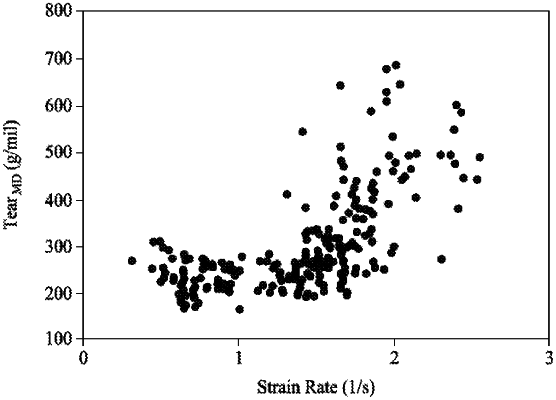| CPC B29C 48/92 (2019.02) [B29C 48/0018 (2019.02); B29C 48/10 (2019.02); C08F 10/02 (2013.01); C08J 5/18 (2013.01); B29K 2023/06 (2013.01); B29L 2023/001 (2013.01); C08J 2323/06 (2013.01)] | 6 Claims |

|
1. A method for forming a polymer film, the method comprising:
generating (1) one or more estimated physical properties of a Polymer A and (2) one or more estimated blown film extrusion conditions using a model comprising a multivariate adaptive regression splines (MARS)-derived algorithm with an input of a desired machine direction tear (TearMD) for a polymer film comprising the Polymer A, wherein Polymer A is a metallocene polyethylene (mPE) synthesized using a hafnium metallocene-type catalyst system;
heating Polymer A to produce a molten Polymer A; and
extruding the molten Polymer A using the one or more blown film extrusion conditions to produce the polymer film;
wherein the MARS-derived algorithm is:
Ln(TearMD)=a1+a2*max(0,a3−MT)−a4*max(0,MT−a3)+a5*max(0,STR−a6)+a7*ρ*max(0,MT−a3)+a8*OR*max(0,STR−a9)−a10*MFR*max(0,a11−PT)+a12*MFR*max(0,a13−STR)+a19*FRR*max(0,STR−a13)−a18*max(0,MT−a14)*max(0,STR−a13)−a15*max(0,a16−PT)*max(0,STR−a17),
where a1-a19 are coefficients derived from experimental data, max(0, x-constant) and max(0, constant-x) result in unitless values, a1 is unitless, a2 is unitless, a3 has units ° F., a4 is unitless, a5 is unitless, a6 has units 1/s, a7 has units cm3/g, a8 has units hr/lb, a9 has units 1/s, a10 has units 10 min/g, a11 has units s, a12 has units 10 min/g, a13 has units 1/s, a14 has units ° F., a15 is unitless, a16 has units s, a17 has units 1/s, a18 is unitless, a19 is unitless, machine direction tear (TearMD) has units g/mil, melt temperature (MT) has units ° F., strain rate (STR) has units 1/s, bulk density (ρ) has units g/cm3, output rate (OR) has units lb/hr, melt flow rate (MFR) has units g/10 min, process time (PT) has units s, flow rate ratio (FRR) is unitless.
|